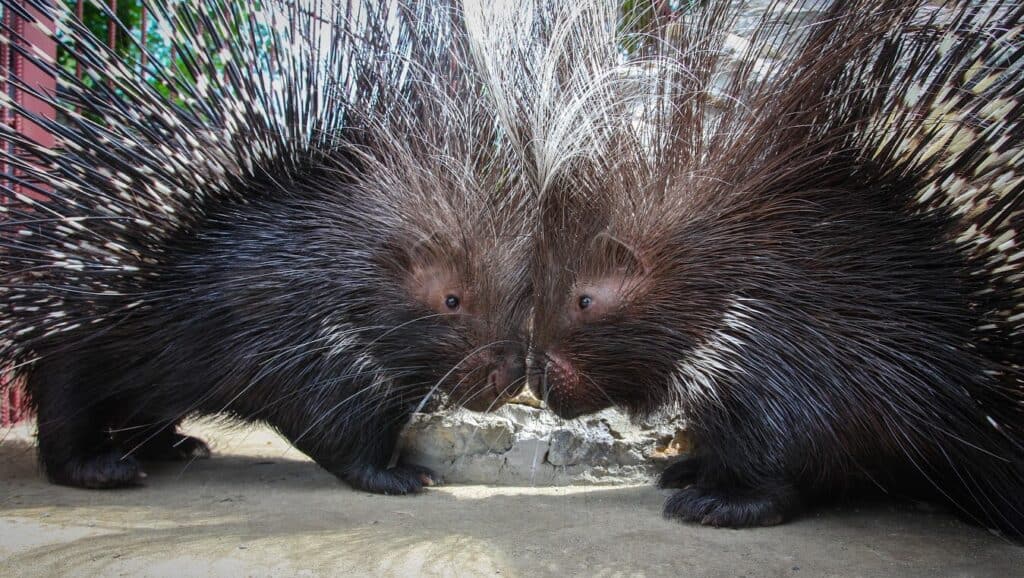Do you want to learn more about pets linked to hedgehogs?
I was with my hedgehog one lovely afternoon and was enjoying its company. I was lost in contemplation and trying to figure out if my hedgehog has any relatives. I looked on the internet but was not persuaded. I decided to consult with my breeder to learn more about this. I’d like to share what I’ve learned with you, and I also encourage you to read my post The World’s Oldest Hedgehog Pet, which contains information about the history and origin of this unusual and amazing pet.
Let’s get started,
6 Amazing Animals Similar To A Hedgehog
Some animals look a lot like hedgehogs but aren’t hedgehogs. I will like to talk about six of them
Porcupine
Porcupines, like hedgehogs, have spines of tough keratin. Porcupines are rodent groups with very similar appearances and quills. Their name, which roughly translates to “prickly pig,” alludes to the large spikes that sprout on their backs and skulls. Quills are seen on all porcupines. Porcupine infants, on the other hand, are soft. These needles harden in layers of hardened keratin. There is a widespread belief that porcupines can shoot quills. They are unable to do so. Instead, the needles are loose in connection, making it easy for them to adhere to the attacking animal and cause pain. Porcupines may be found in North and South America, Italy, Asia, and Africa. Porcupines in North America have much more quills than their European and Asian cousins.
Moon rats
Moon rats have close resemblance with hedgehogs and that is why they are often called primitive hedgehogs. However, many of them at first glance, look like possums. Moon rats do not have spines. Instead, their back hair is coated in a thicker layer of keratin. The hair also sticks to one another, giving it a bristly look. Moon rats are rare such that there is just one species of them. However, depending on the habitat, this species can grow to be three times its original size.
Solenodon
Solenodons resemble hedgehogs but have finer bristles rather than spines. Solenodons are not a popular known animal. One of the two surviving species is found in Cuba, while the other is found in Haiti and the Republic of the Dominican.
Solenodons are little creatures that do not have thorns. but have dense bristles having extra layers of keratin, giving the image of a shrew-hedgehog hybrid cross between them. It is also a poisonous animal. Despite their similarity to the far more common hedgehog, they are highly distinct in their way
Sea urchin
Sea urchins are coated with spines, and their name is derived from the word “hedgehog. They make the list because they are coated with spikes, but the similarities end there. Sea urchins with spiky shells lack a brain.
Furthermore, their calcium spikes are designed to break off when something approaches too close. This is in stark contrast to hedgehogs, which have spikes made of keratin, the same chemical that is used to form human hair and nails. It consumes nearly everything and its food comprises algae, plankton, barnacles, and mussels.
Tenrec
Some tenrecs are so similar to hedgehogs that they are difficult to tell apart at first look. Tenrecs look similar to hedgehogs, porcupines, rats, and even mice. They have strong, keratinized bristles similar to hedgehog quills. However, because all tenrecs dwell in Madagascar, most people are ignorant of their presence. They are, quite popular in zoos, although depending on the species, you may confuse them with more common hedgehogs. Most tenrecs do not weigh many kilograms, the smallest species are about 5 cm long, making them smaller than most mice. The tailless tenrec is the biggest, measuring more than 38 centimetres in length.
Echidnas
Echidnas also have a unique name “spiky anteater” because they have a resemblance to hedgehogs and have long beaks. This species is only found in Australia and New Guinea and is not found anywhere else in the world.
They have keratinized bristly spines. when in fright, they also roll themselves into a ball to avoid any predators. Echidnas, on the other hand, eat mostly ants and termites, unlike hedgehogs. To find prey, they dig and rip through anthills. They then use a long, sticky tongue to capture the ants and draw them with their beak.
What animal group do hedgehogs belong to
A hedgehog is a chordate animal that belongs to the class mammals, the order hedgehogs, and the hedgehog family (Erinaceidae).
According to one theory, the hedgehog was named after the Greek word “chinos,” which means “snake eater.” Another interpretation sees the Indo-European origin “eg’h” in the word “hedgehog,” which means “to prick.”
The European species brown-breasted hedgehog (Erinaceus europaeus) and northern white-breasted hedgehog (Erinaceus roumanicus) are the most well-known hedgehogs (Erinaceidae) Hedgehogs (Erinaceidae) form a family of mammals. The family has around 25 species that are found in Eurasia and Africa. They are classified into two subfamilies based on their appearance: spiny hedgehogs (Erinaceinae) and spineless rat or hairy hedgehogs (Galericinae). The hedgehog’s systematic position is still debated: whether it belongs to the insectivores (Eulipotyphla) or a different order (Erinaceomorpha) at the base of the higher mammals (Eutheria), with newer research favoring the former.
Hedgehogs Evolved From What Animal
Our spiky pals are dinosaur-era terrestrial surviving fossils, and their look has evolved. Our companion has lasted for so long due to its small size, spiky back, and varied diet of insects. It is a mammal of the Erinaceinae Family. Scientists have identified several primitive predecessors of the hedgehog, including the Linoleates, Leipsanolestes, Oncocherus, Cedrocherus, and Deinogalerix, via the study of fossils. Although chemical research and anatomical examination of fossil bones have assisted in linking these early species to current hedgehogs, several of their behaviors and attributes remain a mystery to science.
Hedgehogs are native to the United Kingdom and may also be found in northern and western Europe. Similar and related species can also be found in North Africa, the Middle East, and Central Asia. Hedgehogs are found in portions of Europe, Asia, Africa, and New Zealand and are classified into five genera.
There are no native Australian hedgehogs and no existing North American species. Those from New Zealand are shown.
Before the mating season, the hedgehog population in the United Kingdom is estimated to be approximately 1,555,000. Many people are killed after eating poisoned snails.
Conclusion
Several creatures resemble hedgehogs. However, most of them aren’t even linked. Instead, nature repeatedly produced the same spikes, sharp faces, and tails. Furthermore, practically all of these creatures share another trait. Most places prohibit keeping them as pets. Indeed, many of them are endangered species that cannot be transferred from their nations. You may not be able to keep them as pets, but it is important to know that hedgehogs have what is related to them. I propose that you read my page on Types of hedgehogs, which will provide you with in-depth information on hedgehogs that may be kept as pets.

